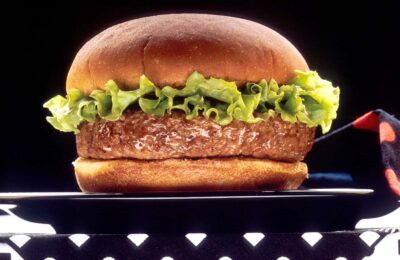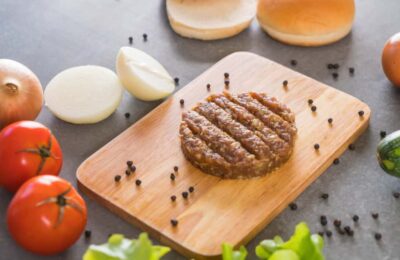Now that we’ve sorted out Who Invented The Burger, let’s move on to its caloric content. Burger buns, the often-overlooked component of your favorite burger, come in various sizes, shapes, and ingredients. Understanding their calorie content involves exploring their composition.
Dissecting Caloric Values of Different Bun Types
Different bun types vary in their caloric content. From classic sesame seed buns to richer brioche options, each holds its unique calorie profile. Let’s break down these numbers. Burger buns come in a spectrum of flavors and textures, each carrying its unique caloric imprint. Let’s delve into the calorie breakdown of various bun types:
- Classic Sesame Seed Bun. The iconic sesame seed bun, adored for its familiar taste and texture, generally clocks in between 120 to 150 calories. The seeds not only add a nutty flavor but contribute slightly to the overall calorie count;
- Brioche Beauty. Indulgent and buttery, the brioche bun tends to be richer in calories, averaging around 150 to 180 calories per serving. Its delightful taste owes much to the eggs and butter in its recipe, elevating its calorie content;
- Whole Wheat Wonder. Often perceived as the healthier choice, whole wheat buns can range from 100 to 140 calories. They tend to contain more fiber, which impacts the bun’s overall calorie density;
- Artisanal or Specialty Buns. Artisanal or specialty buns, with unique ingredients or sizes, can be outliers in the calorie spectrum. These gourmet offerings may reach 200 calories or more, depending on their intricacies and added components;
- Gluten-Free or Low-Carb Alternatives. For those opting for gluten-free or low-carb alternatives, calorie counts may vary significantly. These specialized buns may range anywhere from 70 to 150 calories, often depending on the substitute ingredients used.
Understanding the calorie variations among different bun types allows for more informed choices when crafting or selecting your ideal burger experience. Keep in mind the subtle differences in ingredients and preparation methods as you navigate your burger bun preferences.
Factors Affecting Bun Caloric Content
It’s not just about the bun type; factors like flour, added sugars, fats, and toppings significantly influence a bun’s calorie count. Unraveling these components sheds light on the calorie mystery.
The caloric content of a burger bun is a nuanced interplay of various factors, beyond just its type. Let’s explore the elements that influence the calorie count:
- Flour Varieties. The type of flour used in bun production plays a pivotal role. While traditional buns often use refined flour, some variants incorporate whole grain or alternative flours. Whole grain options generally offer more fiber but might also have slightly higher calorie content due to their denser composition;
- Sweeteners and Additives. Some buns contain added sugars or sweeteners for enhanced taste or prolonged shelf life. These additions contribute to the overall calorie count, making it essential to scrutinize labels for hidden sugars;
- Fats and Oils. Butter, vegetable oils, or other fats are common ingredients in bun recipes. These add richness and moisture but can also elevate the calorie density. Buns with higher fat content typically carry more calories.
- Toppings and Extras. From sesame seeds to oats or other toppings, the embellishments on a bun aren’t just for aesthetic appeal; they affect calories too. These additions, while seemingly small, contribute incrementally to the overall caloric load;
- Size and Thickness. Bun sizes vary widely, from petite slider buns to hefty artisanal creations. The larger or thicker the bun, the more calories it’s likely to contain. Size matters when assessing caloric intake;
- Preparation Methods. Toasting, buttering, or additional embellishments during preparation add layers of flavor but also bump up the calorie count. These variations arise from how the bun is handled before it reaches your plate.
Understanding these nuances helps in deciphering the seemingly straightforward bun and sheds light on the often-unnoticed factors affecting its caloric content. Being mindful of these elements aids in making informed dietary choices without compromising on taste or satisfaction.
Impact of Preparation Techniques on Calories
How you prepare your burger bun matters! Toasting, buttering, or adding additional ingredients can alter the calorie count. Let’s explore how these preparations affect the bun’s caloric load.
The journey of a burger bun from its raw state to a flavorful base involves various preparation methods, each affecting its calorie count. Let’s explore how these techniques impact the bun’s caloric content:
- Toasting. Toasting a bun imparts a delightful crunch and adds a hint of smokiness. However, this process can marginally increase the bun’s calorie count. It evaporates moisture, concentrating the bun’s sugars and potentially elevating the caloric density;
- Buttering or Oil Coating. Brushing a bun with butter or oil before toasting or serving enhances its taste and texture. However, it also introduces additional fat content, consequently raising the calorie quotient. The golden sheen comes at a caloric cost;
- Additional Ingredients. Some recipes call for additional ingredients like garlic butter, herbs, or seasonings applied to the bun’s surface. While these infuse flavor, they contribute extra calories, albeit in relatively small amounts.
- Grilling or Frying. Grilling or pan-frying buns for a crispy exterior can alter their calorie content. While these methods may not drastically impact calories compared to toasting or buttering, they can slightly modify the bun’s overall texture and potential caloric value;
- Steaming or Microwaving. Gentler techniques like steaming or microwaving generally preserve the bun’s original calorie count without significant alterations. They maintain moisture and texture without introducing extra calories through additional ingredients or coatings.
Understanding the effects of various preparation methods on the bun’s calorie content enables you to make conscious choices when assembling your burger. Whether opting for a lighter approach or indulging in a more decadent experience, these nuances empower you to tailor your burger to your dietary preferences.
Making Informed Choices: Using Caloric Knowledge
Understanding the calorie content of burger buns empowers you to make informed dietary decisions. Learn how to balance your burger experience while being mindful of caloric intake.
Understanding the caloric intricacies of burger buns empowers us to make conscious dietary decisions. Here’s how this knowledge can guide our choices:
- Tailored Bun Selection. Knowing the calorie differences among bun types enables us to align our preferences with our health goals. Opting for lower-calorie options like whole wheat or smaller-sized buns allows for enjoyable burgers without excess calories;
- Mindful Pairing. Combining buns with protein sources or fillings of varying calorie densities helps create balanced meals. Pairing a richer bun with lighter fillings or vice versa helps manage overall caloric intake;
- Ingredient Scrutiny. Reading labels and being mindful of added sugars, fats, and artificial additives aids in choosing buns with fewer hidden calories. Seeking out cleaner ingredient lists can contribute to healthier bun choices.
- Smart Preparation. Choosing preparation methods like toasting without butter or lightly oiling the bun reduces extra calories while maintaining taste and texture. These subtle changes can make a notable difference in the overall meal’s calorie content;
- Portion Moderation. Understanding portion sizes and their respective calorie counts assists in moderating intake. Opting for smaller portions or sharing larger burgers allows enjoyment without excess calories;
- Balanced Enjoyment. Balancing the enjoyment of a flavorful burger with an awareness of its calorie components fosters a guilt-free dining experience. Embracing occasional indulgence within a well-rounded diet encourages a positive relationship with food.
By integrating caloric awareness into our culinary choices, we transform meals into mindful experiences. Each decision becomes an opportunity to savor food consciously while honoring our health and wellbeing.
Conclusion
The burger experience isn’t just about taste; it’s about understanding what goes into each component. Appreciating the calorie content of the bun enriches your enjoyment and choices.


